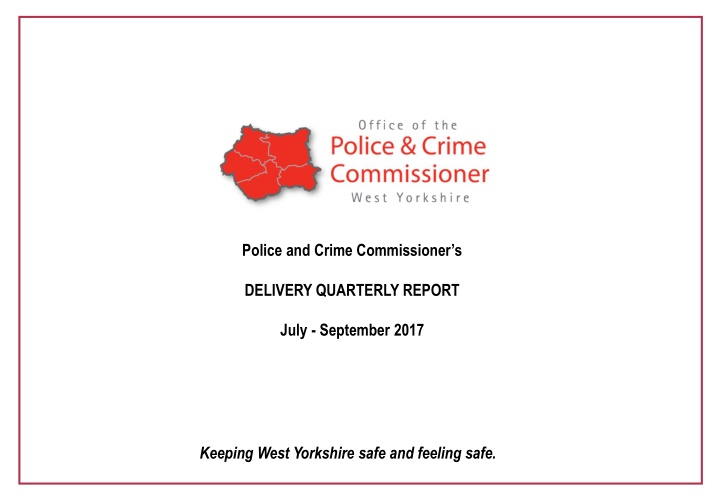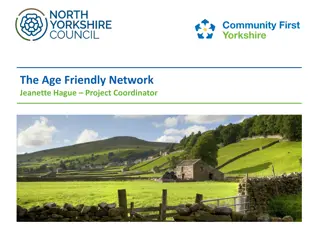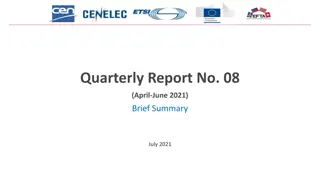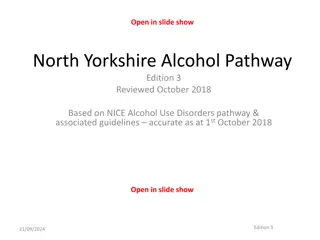Quarterly Report on Keeping West Yorkshire Safe - July to September 2017
This quarterly report highlights the efforts to tackle crime and anti-social behavior in West Yorkshire from July to September 2017. Key areas covered include total recorded crime, risk levels, reoffending rates, police effectiveness, and public perceptions of safety. The report also emphasizes the importance of collaboration with local and national partners to protect communities. Progress made by the Office of the Police and Crime Commissioner, West Yorkshire Police, and other key stakeholders in delivering the Police and Crime Plan is outlined in this report.
Download Presentation

Please find below an Image/Link to download the presentation.
The content on the website is provided AS IS for your information and personal use only. It may not be sold, licensed, or shared on other websites without obtaining consent from the author.If you encounter any issues during the download, it is possible that the publisher has removed the file from their server.
You are allowed to download the files provided on this website for personal or commercial use, subject to the condition that they are used lawfully. All files are the property of their respective owners.
The content on the website is provided AS IS for your information and personal use only. It may not be sold, licensed, or shared on other websites without obtaining consent from the author.
E N D
Presentation Transcript
Police and Crime Commissioners DELIVERY QUARTERLY REPORT July - September 2017 Keeping West Yorkshire safe and feeling safe.
DELIVERY QUARTERLY Trend 12 months to Sept 2016 220,249 (+22%) 10.9% (Sep 16) 3.5%% (Sep 16) 12 months to Sept 2017 252,639 (+15%) 11.8% (Jun 17) 2.9% (Jun 17) Objective Measures Deteriorating Stable Improving Total recorded crime Risk of household crime Risk of personal crime Significantly reduce the volume of crimes committed in West Yorkshire Tackle crime and anti-social behaviour Cohort 1 3.1 Cohort 2 2.8 Cohort 1 - 2.8 Cohort 2 2.5 Stable Significantly reduce the reoffending rate in West Yorkshire Reoffending rates of the managed cohort HMIC PEEL inspections will grade West Yorkshire Police as GOOD or OUTSTANDING at effectively reducing crime Good 2016 82% Good 2017 82.3% Stable HMIC PEEL Effectiveness inspection Stable More people will feel safe in West Yorkshire Feelings of Safety survey (FoS) / Your Views (FoS - 2015) (Your Views) Frontline policing will be protected and resourced to deter, detect and deal with criminals More people will think the police are doing a good or excellent job in their local area More people will be confident that the police and partners will prevent crime and anti-social behaviour HMIC PEEL inspections will grade West Yorkshire Police as GOOD or OUTSTANDING at protecting the vulnerable Proportion of police officers in operational functions will remain the same or improve Stable 93.1% 93.3% Not 50.0% 44.3% Your Views survey comparable Not comparable (PPS Apr 16) 38.6% (PPS Apr 16) Requires improvement (Your Views) 41.1% (Your Views) Your Views survey Improving HMIC PEEL vulnerability inspection Good Safeguard vulnerable people 9,413 missing 26.0% repeat rate (Mar 17) 59.4% (CSEW Mar 17) The volume of people who go missing repeatedly will reduce 9,981 missing 26.6% repeat rate Stable The most vulnerable people will be identified and supported Not Increase the confidence of communities in their community safety partners Your Views survey confidence that the police and CSPs will keep them safe 61.3% Make sure criminal justice comparable (Your Views) Stable Mags: 13.8% Crown: 19.1% Mags: 14.1% Crown: 25.4% Ensure all relevant partners are working together achieve effective results Ineffective trial rate Deteriorating works Ensure all relevant partners are working together to achieve efficient results Have a police service which is more representative of the people it serves. witnesses More victims will be satisfied with the level of service they receive from the service they receive Average time taken for cases to be brought to resolution The demographic breakdown of those recruited into West Yorkshire Police Deteriorating 34.3 days 38.1 days Stable 5.5% BME 5.4% BME victims and Deteriorating Victim satisfaction survey 81.3% 76.6% Support the police More victims who choose to access victims services will be satisfied with Victim services data: Average perception of safety before and after victim services involvement. 4.29 to 5.65 1.36 improvement 4.67 to 5.83 1.66 improvement Stable Page 2
DELIVERY QUARTERLY INTRODUCTION Introduction Tackle crime and anti-social behaviour Tackling crime and anti-social behaviour is a challenging and varied task. Different problems require different responses and different partner s involvement. Together with the police and local and national partners, we will continue to protect our communities by tackling the perpetrators of crime, and reducing the opportunity for crimes to occur. To understand how we can best focus our collective resources, I closely monitor crime levels, measures of public confidence, police service demand, and communities feelings of safety, through the data in this report. This report aims to summarise some of the recent progress made by the Office of the Police and Crime Commissioner (OPCC), West Yorkshire Police and key partners in delivering the Police and Crime Plan. Activity included in this report covers the quarter July to September 2017, and statistics presented reflect the 12 months to September 2017, unless otherwise stated. The report focuses on the four main outcomes of the Police and Crime Plan; tackle crime and anti-social behaviour (ASB), safeguard vulnerable people, make sure criminal justice works, and support victims and witnesses. These outcomes were decided on following extensive consultation with the public, police and partners. We cannot hope to successfully deliver these outcomes unless we all work together. This report sets out our collective progress against each of the delivery measures, but does not contain an exhaustive list of all delivery activity. More information can be found on my website at www.westyorkshire-pcc.gov.uk. Safeguard vulnerable people As with all the outcomes in the Police and Crime Plan, safeguarding vulnerable people requires input from a wide range of organisations. As PCC for West Yorkshire, I have brought partners together to tackle important issues such as child sexual abuse (CSEA), support for people with mental health issues within the criminal justice system, human trafficking and modern slavery, and honour based abuse. I will continue to contribute to this safeguarding agenda by promoting partnership working, for example in our response to children who repeatedly go missing from home. Delivery Overview The data included in this report comes from a range of different sources including national crime statistics and surveys, West Yorkshire Police, HMICFRS inspection reports, partner performance indicators, and consultations carried out by my team. Having a mix of quantitative and qualitative measures allows me to present a more holistic and meaningful report to the public. We also include data from the YourViews survey, which was launched in June to provide data on a range of measures of public confidence and community safety at local level in West Yorkshire. Make criminal justice work It is important that our communities have confidence in our criminal justice system. This report presents measures to help me assess how effectively partner organisations are working together to achieve efficient court processes, and how well West Yorkshire Police s workforce reflects the demographic profile of the local population. Support victims and witnesses The OPCC supports the needs of victims and witnesses in West Yorkshire by funding key services which are delivered by partners in the third sector and district Community Safety Partnerships (CSPs). In this report, I monitor data provided by the police, our own internal research, and that of our delivery partner Victim Support, to understand the needs and experiences of victims and help me evaluate the quality of the service they receive. The Delivery Quarterly report aims to provide a balanced account of police, partner and OPCC delivery over the past quarter. I hope that by including details of our progress in tackling crime and community safety issues as a collective, we can help our communities understand and be reassured by our unified approach. As I have said before, keeping West Yorkshire safe and feeling safe cannot just be left to the police. Page 3
TACKLE CRIME AND ANTI-SOCIAL BEHAVIOUR DELIVERY OVERVIEW Recorded Crime Bradford Calderdale Kirklees Leeds Wakefield West Yorks. +22% +15% 252,787 Objective: Significantly reduce the volume of crimes committed in West Yorkshire Volume of total crime Sept 16 to Sept 17 12 mths to Sept 16 12 mths to Sept 17 Vol. (to Sept 2017) +22% +19% 65,305 +28% +12% 21,796 +17% +17% 39,454 +20% +13% 92,780 +27% +12% 33,752 25000 Commentary Recorded crime has increased by 14.9% when the 12 months to September 2017 are compared to the preceding 12 months. This continues to stabilise with an increase of 11.9% in the first six months of this financial year. Much of the increase in recorded crime is due to improved crime recording practices. The Crime Survey of England and Wales (which is not affected by recording practices) shows that the risk of becoming a of victim crime in West Yorkshire is decreasing year on year. West Yorkshire Police carry out in-depth analysis of crime data and have noted rises in certain crimes which are due to increased offending and not recording practices. These are discussed on page 6 of this report. 20000 15000 10000 5000 0 Sep-16 Nov-16 Jan-17 Mar-17 May-17 Jul-17 Sep-17 Reoffending rates 12 months to Sep 15 Adults Youths Bradford Calderdale Kirklees Leeds Wakefield West Yorks. 29.4 40.9 Objective: Significantly reduce the reoffending rate in West Yorkshire Reoffending rates (%) 29.1 41.4 27.7 52.8 24.3 33.8 27.9 41.2 30.1 42.0 50.0 40.0 Commentary Reoffending rates taken from Ministry of Justice data record the proportion of offenders released in a given year who go on to reoffend in the following twelve months. Figures for the year to September 2015 record a reoffending rate for West Yorkshire adult offenders of 29.4% (a stable trend), and of 40.9% (deteriorating trend) for youths. The slight (but not significant) rise in September 2015 is due to first time entrants being removed from the cohort, leaving a core of more complex offenders. Calderdale s youth reoffending rate is typically higher than other districts, however this difference is growing. I will be addressing this, along with wider issues through the reducing reoffending strategy and as chair of the LCJB. 30.0 20.0 10.0 0.0 Sep-11 Mar-12 Sep-12 Mar-13 Sep-13 Adults Mar-14 Youths Sep-14 Mar-15 Sep-15 Objective: Frontline policing will be protected and resourced to deter, detect and deal with criminals % of workforce in operational functions % in operational functions 2016 2017 Change Mar 93.2% 93.1% -0.1% Jun 93.0% 93.4% +0.4% Sept 93.1% 93.3% -0.1% Dec 93.1% - - 95.0% Commentary The proportion of police officers in operational functions currently stands at 93.3% representing a stable trend. This level is high in comparison to other police forces across England and Wales, and has been noted as a success by HMIC in their 2017 Efficiency inspection report (released Nov. 17). This inspection once again graded West Yorkshire as GOOD. Work is ongoing within West Yorkshire Police to ensure that when we increase our capacity through the recruitment of new officers, we also improve our capability too. Detail regarding this can be found on page 6. 94.0% 93.0% 92.0% 91.0% 90.0% Jun-14 Dec-14 Jun-15 Dec-15 Jun-16 Dec-16 Jun-17 Page 4
TACKLE CRIME AND ANTI-SOCIAL BEHAVIOUR DELIVERY OVERVIEW Objective: More people will feel safe in West Yorkshire Your Views Survey (Sept. 2017) West Yorks. Bradford Calderdale Kirklees Leeds Wakefield How safe do you feel in your local area? 82.3% 76.0% 86.0% 84.4% 84.8% 80.3% % feeling safe 90% 86.0% Commentary The data here comes from the Your Views Survey, which replaced our previous Public Perception Survey. It is important to note that this data is based on responses from one quarter only (July-Sept) and as such the sample is relatively small (around 4,200). It is likely that we will see some slight fluctuations over the next two quarters as this dataset develops, and we will then be able to draw more statistically valid comparisons and begin to assess trends over time. Nevertheless, it is encouraging that 82.3% of respondents felt either safe or very safe across West Yorkshire. We saw similar high scores in our Feelings of Safety Survey in 2015. 84.8% 84.4% 85% 82.3% 80.3% 80% 76.0% 75% 70% Leeds Wakefield Kirklees Calderdale Bradford West Yorkshire Your Views Survey (Sept. 2017) West Yorks. Bradford Calderdale Kirklees Leeds Wakefield Objective: More people will think the police are doing a good or excellent job in their local area % good / excellent 44.3% 36.5% 41.3% 43.7% 51.3% 42.8% % who feel the police are doing a good or excellent job 60% 51.3% Commentary Again, these results are based on the responses from just one quarter s worth of data so should be considered only as an indication of perceptions at a point in time and not as a trend. 44.3% of respondents across West Yorkshire felt that the police were doing a good or excellent job in their local area, with Leeds being a positive outlier. We asked the same question in the previous PPS survey, and although the datasets are not true parallels, the results are similar to those in April 2016. Encouragingly, the Crime Survey of England and Wales also asks this question and returns stable results for West Yorkshire around the 55% mark. 44.3% 43.7% 42.8% 50% 41.3% 36.5% 40% 30% 20% 10% 0% Leeds Wakefield Kirklees Calderdale Bradford West Yorkshire Objective: More people will be confident that the police and partners will prevent crime and anti-social behaviour % who feel police and partners will prevent crime and ASB Bradford Calderdale Kirklees Leeds Wakefield Your Views Survey (Sept. 2017) % confident / very confident West Yorks. 41.1% 33.6% 40.0% 41.7% 46.4% 39.9% 46.4% 50% 41.7% 41.1% 40.0% 39.9% Commentary The Your Views survey now has an increased focus on partnership working within local communities and asks respondents whether they feel confident that the police, local authority, and public sector partners ( community safety partners ) work well together across a range of issues. 41.1% of respondents said they were confident or very confident that community safety partners would prevent crime and ASB. Generally speaking, respondents had less confidence in their local partners tackling crime and ASB compared to the other issues measured, which included protecting the vulnerable, supporting victims, keeping the area clean, and listening to people s concerns. 40% 33.6% 30% 20% 10% 0% Leeds Wakefield Kirklees Calderdale Bradford West Yorkshire Page 5
TACKLE CRIME AND ANTI-SOCIAL BEHAVIOUR DELIVERY OVERVIEW West Yorkshire Police Delivery OPCC Delivery In recent Delivery Quarterly meetings with the Chief Constable, I have asked a number of questions relating to the performance of West Yorkshire Police in tackling crime and anti-social behaviour. I have paid particular attention to the progress of the Force Crime Management Unit (FCMU). FCMUis a specialist department set-up to deal with the response to certain crimes and help relieve the pressure on district staff. The Chief Constable explained that FCMU is gradually taking on more crime categories, with theft from vehicle and make-off without payment being added during this quarter. Bespoke investigative plans have been developed for specific crime categories to ensure consistency of service. Early indications show that victims who have their crimes dealt with through the FCMU are at least as satisfied (and often more satisfied), than those who have their crime managed through district police services. The increases in recorded crime levels in West Yorkshire over the past two years are largely due to improved recording practices and are now beginning to slow. West Yorkshire Police have put a great deal of effort into ensuring that they are correctly recording crimes in accordance with national standards. The crime recording compliance rate as of September 2017 stood at 88% and work is ongoing to bring this above 90%. West Yorkshire Police carries out extensive analysis of crime data and assesses that the risk of becoming a victim of crime has increased by between 4-5%. This is largely attributed to a few specific crime types such as non-injury violence, sexual offences, some acquisitive crime offences (such as commercial robbery), shoplifting, and theft from vehicles. Similar trends are being seen nationally and the police service as a whole is working towards using more innovative problem solving approaches to reduce these crimes. Some examples of action being taken in West Yorkshire include: HMIC recently released their national inspection into Human Trafficking and commented on the good progress made by West Yorkshire Police and the National Anti-Trafficking Network that I established in 2016. We have been instrumental in West Yorkshire in working with the police and partners to bring this issue to the fore. Although there is a lot of work to do to standardise practice across the country, I am reassured by the progress made in the last two years. Investment in the central Firearms Prevent Team: the team provides oversight and direction to district teams, takes responsibility for more serious cases, and works with regional police forces and organisations such as the NCA. Crucially this team also focuses on initiatives to get upstream of the issue, such as diversionary programmes with youths who are at risk of being drawn into gangs. Since this team was formed in June 2017 it has already had some great early successes. I look forward to seeing further progress going forward. In August I took the opportunity to spend a day with members of Wakefield Neighbourhood Policing Team (NPT) and the Customer Contact Centre (CCC) to witness first hand the issues which they deal with on a typical shift. I was impressed with the dedication and professionalism of these teams and was pleased to have the chance to discuss their ideas on how we can continue to keep West Yorkshire communities safe. For more information on your local NPT and how to get involved, please visit the West Yorkshire Police Website at www.westyorkshire.police.uk/npt. Recent high profile cases in the media relating to non-recent CSEA (and the efforts of West Yorkshire Police and partners in raising awareness about these crimes), has contributed to an increase in the reporting of sexual offences. West Yorkshire Police has dedicated teams in place to investigate CSEA, and works closely with other partners to support victims and build a climate where people have the confidence to report CSEA offences. Over the last quarter my office has been working with West Yorkshire Police and other key agencies in each district to establish Serious Organised Crime Partnerships. The aim of these groups is to ensure that different organisations are more coordinated in their approach towards tackling serious and organised crime in their local area, and to improve the sharing of intelligence between agencies. This work is in its infancy but will ultimately bring a strong partnership approach to disrupting organised crime across West Yorkshire and the region. With the support of my office, West Yorkshire Police scyber team launched the first cyber-schools contest in September. 26 schools have registered to take part and teams are tasked with creating an engaging website, impactive leaflet, or phone app aimed at helping people to stay safe online. The contest may also encourage young people with the interest and skills to help counter cyber crime in the future. Page 6
TACKLE CRIME AND ANTI-SOCIAL BEHAVIOUR DELIVERY OVERVIEW West Yorkshire Partners Delivery OPCC Delivery In June, I launched the new Your Views survey which replaced the long running PPS survey. My office has been working closely with the police and partners over the past year to develop the new survey. It is a large-scale postal survey which is sent out to around 111,000 addresses each year, and asks respondents how they feel about various community issues, the police, and local partners in their area. My office has analysed the results from the first quarter and has shared them with the police and partners as early indications of public opinion in their areas. This has been well received and will help direct work around improving community safety going forward. Our partners across the districts of West Yorkshire are continuing to lead on vital work to build safer communities. Headlines from the last quarter include: Calderdale Calderdale Council have welcomed a new 24 hour Community Safety Warden Service, creating a step-change in the way the Council responds to nuisance and quality of life issues. It will complement existing council services and partners by focusing on enforcement and visibility. Duties include: issuing fixed penalty notices for offences such as dog fouling; management of unauthorised traveller encampments; licensing checks; tackling low level environmental issues such as noise nuisance and fly-tipping; and vulnerability and offender visits. The Wardens will address priorities identified through local partnership arrangements in communities across Calderdale. With support from my office, Leeds Beckett University and West Yorkshire Police have developed new ways of fighting cyber crime and supporting digital investigations. Specific outputs of the project include a grooming detection tool for the automated analysis of online chat logs, a prototype mobile app to support frontline officers in capturing evidence, and provision of enhanced cyber training. This work continues to put West Yorkshire in a better position for tackling cyber-crime. Bradford Bradford CSP recently ran two 6 week projects in which groups of boys and young men focused on the impacts of ASB. This involved a residential visit for each group with the theme of realmen - giving participants the space to explore masculinity, society, and expectations. West Yorkshire Fire and Rescue Service(WYFRS) WYFRS has teamed-up with West Yorkshire Police to develop its crime prevention training as part of their programme of community support, offering free crime prevention advice to help deter burglars. In August 2017 the value of awards through my Safer Communities Fund topped 1.9M since its start in 2014. In the latest round I returned a further 213,940 of money seized from criminals to community projects in West Yorkshire. 50 projects were successful in the latest round which invited groups to apply for funding to address four Police and Crime Plan priorities; community cohesion, missing people, radicalisation, and road safety. The fund was open to applications during September and my team are currently reviewing these bids to find the next set of successful projects. Wakefield As part of ongoing work to tackle serious acquisitive crime (including vehicle crime), Wakefield CSP are delivering an enforcement campaign to run alongside its darker nights operation. The project provides advice on targethardening to help prevent crime, and when a crime has been committed, to provide reassurance and security to the victims. I have been pleased to continue supporting the partnership formed between West Yorkshire Police, the University of Huddersfield, and West Yorkshire Cub Scouts. Last year the Cub Scouts launched their Crime Prevention badge, and Cubs from Bradford, Calderdale and Kirklees were the first to receive this award after completing a programme of crime busting activities. This year, cubs from Central Yorkshire Scouts (Leeds and Wakefield), had the same opportunity to learn about crime prevention. These young people will now be helping to safeguard our communities by passing on their knowledge to their family and friends Leeds Anti-Social Behaviour Early Assessment Team (LASBEAT) In the few months since their inception, LASBEAT have focused on identifying victims of ASB with additional vulnerabilities, and developing a multi-agency approach to meet individual s needs. As a result of this work there has been a noticeable reduction in call demand from members of the public who are most likely to be in danger of harm. Page 7
SAFEGUARD VULNERABLE PEOPLE DELIVERY OVERVIEW Objective: HMIC PEEL inspections will grade West Yorkshire Police as GOOD or OUTSTANDING Commentary In February 2017, HMIC released its Effectiveness inspection report for WYP which completed the 2016 PEEL assessments. WYP were graded as GOOD across all three strands of assessment. In a time of increasing demand and budgetary pressures, it has been necessary for the police and partners to re-align their resources to the areas of greatest risk (such as child sexual exploitation, missing people, domestic abuse, and human trafficking). PEEL identified that WYP s effectiveness in safeguarding had been an area of significant improvement. *In November, the 2017 PEEL inspection report on West Yorkshire Police s Efficiency was updated, and the Force have retained their Good grade. The report commended WYP s understanding of emerging crime threats such as modern slavery and honour-based abuse. PEEL Assessment 2016/17 GOOD GOOD* GOOD Effectiveness Efficiency Legitimacy Objective: The rate of people who go missing repeatedly will reduce Missing / Absent people 12 months to September 17 No. missing people Repeat missing peo. Repeat rate West Yorks. 9,981 2,659 27% Bradford Calderdale Kirklees Leeds Wakefield 4,000 28.0% 2,926 807 28% 964 270 28% 1,452 370 25% 3,334 870 26% 1,268 317 25% 27.0% 3,000 26.0% Commentary 9,981 people were reported missing or absent in the 12 months to September. 2,659 went missing on more than one occasion, resulting in a missing person repeat rate of 27%. Individuals who go missing repeatedly are often vulnerable and have much more complex needs. WYP s safeguarding crime reduction officer has worked with Huddersfield University to look at the issues behind why children go missing. The findings of this work will link into West Yorkshire Police s new earlyintervention strategy. 2,000 25.0% 1,000 24.0% 0 23.0% Bradford Calderdale Kirklees Leeds Wakefield Volume Repeat Rate Objective: Safeguarding boards in West Yorkshire will comply with their statutory roles and responsibilities Good progress Each policing district has a co-located investigative team with partners to deal with child safeguarding issues. boards consistently. The Safeguarding Central Governance Unit (supporting by safeguarding boards) has provided training sessions to Ports unit staff in the region to help identify safeguarding risks. Take forward learning from the Safeguarding Adults Review relating to the resilience of safeguarding agencies. Ongoing objectives Commentary This is one of the new measures in the Police and Crime Plan and has been included to provide a qualitative level of detail around the partnership working arrangements for safeguarding in West Yorkshire. In each district there is an adult safeguarding board and a safeguarding children board, meaning that we have ten boards in total which have a list of statutory roles and responsibilities. In October a workshop was held for representatives of the boards to discuss the development of their work. The event concluded with the proposal that an overarching governance body in West Yorkshire would help to co-ordinate communication strategies, information sharing and training, and reduce duplication between districts. Ongoing work needed to ensure the Care Act 2015 has been embedded across all Work in a more joined up way to share best practice across organisations and safeguarding boards. Work to further develop performance frameworks is ongoing across partnerships. Page 8
SAFEGUARD VULNERABLE PEOPLE DELIVERY OVERVIEW West Yorkshire Police Delivery West Yorkshire Partners Delivery West Yorkshire Fire and Rescue Service s Safe and Well visits are provided to vulnerable people across West Yorkshire to offer fire prevention advice. The project has been enhanced in partnership with West Yorkshire Police and Trading Standards to help teams spot when someone might be vulnerable to becoming a victim of crime. Through Safe and Well, WYFRS is able to offer advice to help reduce vulnerability and provide signposting to support services. Over the next two years, training will build officers capabilities on falls and personal mobility, cold homes, smoking cessation, and social isolation. The HMIC have recently released two reports which highlight West Yorkshire Police s work on safeguarding. A national report on police forces response to modern slavery and human trafficking identified our local commitment to tackling these crimes; West Yorkshire Police (WYP) are second in the country for the volume of modern slavery/human trafficking offences which are recorded. The latest PEEL Efficiency report awarded WYP a Good grading. On the Force s understanding of demand for services, HMIC praised its awareness of emerging crime threats such as modern slavery, child sexual abuse, and honour-based abuse. Based in Wakefield city-centre on Friday and Saturday nights, the Night Marshall and Street Angel service is run by the local authority and West Yorkshire Police. The service helps to diffuse conflict situations and keep people safe who are vulnerable or intoxicated. Night Marshals provide a greater sense of safety for visitors and support the Street Angels who provide help to anyone who may be in distress. This is one of a number of projects funded by the CSP which help to prevent crime and tackle ASB. Supported by the College of Policing s Knowledge Fund, West Yorkshire Police has worked with Leeds Beckett University on an 18-month investigation in how digital crime is policed across the country. The project aimed to bring an evidence-based approach to the policing of digital forensics and cybercrime investigations, and has helped to develop new procedures, new capabilities, and gather valuable intelligence. OPCC Delivery OPCC Delivery Tackling mental health, raising awareness of domestic abuse, and providing awareness of doorstep crime were all topics covered as part of West Yorkshire's Safeguarding Week. Between the 9th and 15th October, local safeguarding boards and community safety partnerships across the region joined forces with the OPCC and West Yorkshire Police to hold workshops and events aimed at informing the public and professionals about how to protect vulnerable people across the region. Horton Housing in Bradford has benefited from a 2,500 grant from the OPCC Safer Communities Fund. Horton Housing is a not-for-profit organisation that helps the most vulnerable people in society by providing housing, training, and support services across Bradford, Calderdale, Kirklees and North Yorkshire. They work with a wide range of clients including people who have mental health problems, drug or alcohol issues, refugees, ex-offenders, or people with disabilities. Their project provides information to equip clients with tenancy ready skills , like how to sustain a tenancy, and how to be a good neighbour and valued member of the community. The West Yorkshire Criminal Justice and Mental Health Forum is co-ordinated by the OPCC to ensure that partners are working collectively to help those suffering damaging mental wellbeing problems who have contact with the criminal justice system. At September s meeting, the forum discussed the places of safety which have been established to support people who are experiencing mental health crisis or who are intoxicated and have been taken into custody. The group also discussed the draft Suicide Prevention Strategy, which calls for police, ambulance, and local authority partners to work in partnership with the NHS to appropriately support those at risk. I hosted the first ever Restorative Justice Volunteer Recognition Event at the Civic Hall in Leeds in September. Restorative Justice (RJ) aims to help victims cope and recover from the harm caused by crimes committed against them. With OPCC support, each district across West Yorkshire now has access to skilled RJ practitioners. Volunteer RJ practitioners are pivotal to the success of the service and this event provided an opportunity to thank each of them for the important contribution they make. Page 9
MAKE SURE CRIMINAL JUSTICE WORKS DELIVERY OVERVIEW 12 months to Sept. 17 Agree % West Yorkshire 49.3% Objective: Increase confidence of communities in their community safety partners % who are confident that their local community safety partners will listen and respond to their concerns Bradford Calderdale Kirklees Leeds Wakefield 44.9% 48.% 49.3% 54.1% 45.7% Commentary The Your Views survey includes a series of questions focused on the work of CSPs, including whether respondents are confident that they will keep people safe, protect the vulnerable, prevent crime, keep the area clean, and listen to communities concerns. The graph shows the first quarter s data and the proportion of respondents who were confident that CSPs will listen and respond to their concerns. This is one of the measures in the survey which shows the least variation across the districts, however Leeds is still an outlier. Due to the relatively small sample sizes, comparisons between districts at this stage should be carried out with caution. 54.1% 60% 49.3% 49.3% 48.0% 45.7% 44.9% 40% 20% 0% Leeds Wakefield Kirklees Calderdale Bradford West Yorkshire Commentary The ineffective trial rate at Magistrates Courts (black line) had been continuing to drop over the last year, surpassing the ambition of an effective trial rate of 85% at Magistrates Courts. However, in the last two quarters the rate has risen slightly. The current ineffective trial rate at stands at 16.6%, just falling short of the national target. Objective: Ensure relevant partners are working together to achieve effective and efficient results Ineffective trial rate & average time taken to resolve cases Sept. 2015 - Sept. 2017 50 50 Similarly the time taken for cases to be brought to resolution at Magistrates Courts (blue line) has also been steadily reducing over this period, dropping to a low of 27.5 days in May. Unfortunately, this figure has also risen in the last quarter and now stands at 38.1 days. 40 40 No. of days % of trials 30 30 20 20 Both of these increases are an area of focus for the LCJB, and some of the work being done to improve performance is detailed on page 11. The courts are experiencing a period of unprecedented change, with reductions in staff numbers and the implementation of new digital administration systems. The LCJB is working closely with the courts during this programme of change. 10 10 0 0 Sep-15 Dec-15 Mar-16 Jun-16 Sep-16 Dec-16 Mar-17 Jun-17 Sep-17 Objective: Have a police service which is more representative of the people it serves % of workforce from a BME background Commentary The proportion of the police service in West Yorkshire from BME communities has increased gradually over the past few years, from 4.8% in June 2014 to 5.4% June 2017. In September 2017 this figure stood at 5.3%, representing a stable trend. West Yorkshire Police are also working towards recruiting more people from other under-represented groups, including women, people with disabilities, people from a wider distribution of age groups, and members of the LGBT community. Whilst data is readily available on police workforce ethnicity and gender, it is more difficult to collate data relating to other demographic strands as staff are not obliged to provide it. The data that we do have shows us that 44.3% of new recruits (since April 2016) are female, and 39% are aged between 26-40 years. 5.6% 5.4% 5.2% 5.0% 4.8% 4.6% Sep-14 Jan-15 May-15 Sep-15 Jan-16 May-16 Sep-16 Jan-17 May-17 Sep-17 Page 10
MAKE SURE CRIMINAL JUSTICE WORKS DELIVERY OVERVIEW West Yorkshire Police Delivery HM Courts & Tribunal Service has been working through challenges associated with the ongoing digital transformation programme. Unfortunately this has had a negative impact on the ineffective trial rates and time taken for cases to reach resolution. Thanks to the earlier progress made through the Transforming Summary Justice and Better Case Management programme, West Yorkshire is still in a good position when compared to the national averages, but we will need to continue working together to help the courts overcome these issues. West Yorkshire Police have been contributing to these efforts by focusing on the quality of case files, and where possible, helping to reduce the number of cases going to Crown Court unnecessarily. West Yorkshire Partners Delivery Partners across West Yorkshire are committed to working together to improve the criminal justice and community safety systems. To support this work, my office passes funds over to each of the five CSPs to support the delivery of the Police and Crime Plan. In the recent quarter, Wakefield CSP used some of this funding to support its multi-agency neighbourhood coordination groups. This enables the CSP to commission voluntary and community organisations to deliver intelligence-led projects and activities to tackle local issues. I fully support and encourage using this social action approach with third sector organisations working alongside public agencies in our communities. I recently attended an event which brought together agencies from across West Yorkshire to share expertise and best practice to beat organised crime. The conference was one of a number being held across West Yorkshire and included partners such as housing agencies, the Environment Agency, and local authorities. Key subjects discussed included good practice in collecting evidence, what organised crime looks like nationally, and the financial impact it can have on local economies. With the help of the Police and Crime Panel and the public of West Yorkshire, I have been able to raise funds for new officers over the past two years through small increases to the council tax precept helping to increase our capacity to keep West Yorkshire safe. In response, the Chief Constable has been able to invest in her workforce s capabilities through training in the use of digital tools, an investigations review, and through the wider neighbourhood policing review. OPCC Delivery OPCC Delivery I have recently taken over as chair of the Local Criminal Justice Board (LCJB) which brings together local representatives from across the criminal justice system to improve effectiveness and efficiency. In the most recent meeting, the Board discussed a range of issues relating to agencies across the criminal justice system. These included, body worn cameras, the use of bail, sharing of information, and the recent Lammy Report. The new Your Views survey has recently been launched and the first quarter s data has now been analysed and shared with partners. There are already some very useful findings which will help guide and inform the OPCC, police, and partners around the issues which matter to our communities. The Your Views survey includes questions about community safety partners as well as the police and my office is working closely with the five CSPs to make use of this information. In the July 2017 Community Outcome Meeting, the Chief Constable updated me on progress made around the investment in digital devices (including body worn cameras), as part of every-day policing. We also discussed how people with mental health issues are supported through the criminal justice system, which includes working with partners across the sector. HMIC have also recently recognised the good work of West Yorkshire Police and Mental Health Nurses in supporting people in crisis, which benefits not only the individual but the wider community and criminal justice system. For more information about our Community Outcomes Meetings, please see my website: www.westyorkshire-pcc.gov.uk. My Youth Advisory Group (YAG) is now in it s fourth year. It consists of members aged between 13 and 21 years old, who meet throughout West Yorkshire to give their views and comments to inform our decisions on policy and community engagement. Young people have a unique and valued point of view and it's really important that they are involved in decision making. YAG plays a crucial role in helping us to successfully represent young people s perspective on the criminal justice system. To find out more about the Youth Advisory Group, and to apply to become a member, visit www.westyorkshire-pcc.gov.uk/get-involved/youth-advisory-group.aspx Page 11
SUPPORT VICTIMS AND WITNESSES DELIVERY OVERVIEW Objective: More victims will be satisfied with the level of service they receive from the police Overall satisfaction levels Sept. 2015 Sept. 2017 User Satisfaction Bradford Calderdale Kirklees Leeds Wakefield West Yorks. 77.7% 76.6% 12 mths to Sep. 16 12 mths to Sep. 17 79.9% 73.1% 80.6% 76.3% 80.9% 76.7% 82.7% 79.5% 80.8% 76.2% 100.0% Commentary Latest data from West Yorkshire Police s survey of victim satisfaction shows a continuation of falling satisfaction rates. 76.6% of victims of crime were satisfied with the level of service they had received in the year to September 2017. The PCC is closely monitoring the Force s work to improve their service to victims, in particular the role the new Force Crime Management Unit (FCMU) can play. One third of calls to the police are now handled by FCMU, and it is hoped that their improved investigation plans and advice for district officers should soon act to boost victim satisfaction levels. 90.0% 80.0% 70.0% 60.0% 50.0% Sep-15 Dec-15 Mar-16 Jun-16 Sep-16 Dec-16 Mar-17 Jun-17 Sep-17 Objective: More victims who choose to access victims services will be satisfied with the service they receive Victim Support scores before and after accessing service Commentary Victim Support track the impact of their service on the clients who access their support or who are referred by agencies such as the police. The chart shows the average satisfaction scores (marked out of 10) which clients give at the start and the end of their contact with Victim Support. Encouragingly, all scores improve after the support is provided. 10 5 In this quarter, the average value of the post-intervention scores increased in all categories, recording increasing satisfaction with Victim Support s service. Clients scores for wellbeing and perception of safety increased by roughly 25% after intervention from Victim Support. Your Views 0 Reintegration Perception of safety Wellbeing Feeling informed Initial response Final Response Objective: More victims will be satisfied with the outcome of their case Bradford Calderdale Kirklees Leeds Wakefield Victim satisfaction Apr. Oct. 17 West Yorks. 63.6% % satisfied with outcome 68.9% 60.9% 57.6% 64.6% 64.6% 70% Commentary Home Office restrictions on how the police survey the victims of crime have now been lifted, allowing West Yorkshire Police to ask tailored questions to help better understand people s opinions on the service they provide. The latest data covers April to October this year and records that 63.6% of victims were satisfied with the outcome of their case. Bradford recorded the highest rates of satisfaction (68.9% of victims satisfied with outcome) and Kirklees the lowest (57.6%). These figures are based on a relatively small total of 850 responses. We will continue to monitor results in the months ahead as the volume of responses at district level starts to build in size. 65% 60% 55% 50% West Yorkshire Bradford Calderdale Kirklees Leeds Wakefield Page 12
SUPPORT VICTIMS AND WITNESSES DELIVERY OVERVIEW West Yorkshire Police Delivery West Yorkshire Partners Delivery The proportion of victims who are satisfied with the service they receive from West Yorkshire Police has continued to decline, falling to 76.7% in the year to September. The reduction in victim satisfaction has been influenced by victims of vehicle crime, however, satisfaction levels for violent crime, burglary and ASB have also fallen. Keeping people informed of progress is the service area that is receiving the weakest scores from victims. In Wakefield, the CSP is working with a third sector organisation to provide support for victims of domestic abuse who are assessed as having lower risk. The support is being targeted on those who are repeat victims, but who choose not to accept help from statutory services. Enhanced support and guidance will also be provided through a project which will improve joint-working with local GPs. This year s 16 Days of Action Against Domestic Abuse will focus on coercive control and in particular, Leeds campaign will look to increase engagement with men across the city. In Leeds, Domestic Violence Ambassadors are being recruited across the council to disseminate information and signpost colleagues and customers to places of support. The Force Crime Management Unit (FCMU) will help to make improvements in this area as staff are specifically tasked with calling victims to keep them updated. The FCMU are now handling around one third of all calls from the public; those calls which are dealt with entirely by FCMU record high levels of satisfaction. In time, data from West Yorkshire Police snew victim satisfaction survey will help us to better understand the factors behind victims dissatisfaction. In the meantime, the force understands there is a need to manage callers expectations of what they can do in response to their call, and improve the police s signposting of other support services. Support for the LGBT and Trans communities is being provided by the Bradford East youth partnership through the Sound and Phoenix youth groups. Both groups provide a safespace for young people, as well as offering awareness and training to promote inclusivity in local service provision. OPCC Delivery OPCC Delivery OPCC supported West Yorkshire Financial Exploitation and Abuse Team is achieving positive results. The team is made up of specialists from the Police, local authority social care, and Trading Standards. The team recently secured a conviction against a rogue trader, Andrew Pollard, who pleaded guilty at Leeds Crown Court to ten offences under The Consumer Protection from Unfair Trading Regulations 2008. Prior to the school summer holidays, West Yorkshire Police launched a campaign highlighting the issues of forced marriage and honour-based abuse (HBA). From June 2014 it became a crime to force someone to marry against their will. The police can apply for Forced Marriage Protection Orders to put legally binding conditions on those involved in trying to pressurise another person to marry. The Shipley Youth Advice Advocacy Project has received 5,000 from the OPCC Safer Communities Fund. The money has gone towards the continued running of a project to empower 16-25 year olds to take action on poor housing and homelessness. Victims of sexual exploitation, honour based abuse, and human trafficking are among the most vulnerable groups accessing the project s specialist housing, benefit and debt advice. Tackling forced marriage and honour-based abuse is a priority in the Police and Crime Plan 2016-21. There are specialist safeguarding units in each district of West Yorkshire with professionals who understand the issues and who can provide victims with appropriate support. The OPCC and West Yorkshire Police will continue to work closely with key partners, such as national charity Karma Nirvana, to raise awareness of these difficult issues, and encourage victims and survivors to come forward. I renewed my commitment to the cause on Friday July 14th at the Day of Memory conference in Leeds. I joined Leeds District Police Commander, Paul Money, in signing a pledge to continue to provide victims of HBA with the protection they deserve. In July, the OPCC helped to promote the Modern Slavery Helpline across West Yorkshire. Posters and promotional materials were distributed to neighbourhood policing teams and the five district human trafficking and modern slavery networks. It is hoped that the helpline will give victims the confidence to come forward and look for advice and support to escape their situation. Page 13
GLOSSARY Acquisitive crime Human trafficking Acquisitive crime is defined as an offence where the offender derives material gain from the crime. Examples include, shoplifting, burglary, theft, and robbery. BME stands for Black and Minority Ethnic and is used to describe people of this ethnicity. Human trafficking is the trade of humans, most commonly for the purpose of forced labour or commercial sexual exploitation by the trafficker or others. Integrated Offender Management (IOM) is an overarching framework that allows local and partner agencies to come together to ensure that the offenders whose crimes cause most damage and harm locally are managed in a co-ordinated way. An ineffective trial occurs when the trial does not go ahead on the date planned due to action or inaction by one or more of the prosecution, the defence or the court and a further listing for a trial is required. Most Similar Groups (MSGs) are groups of police force areas that have been found to be the similar to each other based on an analysis of demographic, social and economic characteristics which relate to crime. Each police area has its own group of up to seven police areas to which it is most similar . MSGs are designed to help make fair and meaningful comparisons between police areas which share similar characteristics, rather than, for example, comparison with a neighbouring police area. IOM BME Child sexual exploitation and abuse Sexual exploitation of children and young people under 18 involves exploitative situations, contexts, and relationships where young people (or a third person or persons) receive 'something' (e.g. food, accommodation, drugs, alcohol, cigarettes, affection, gifts, money) as a result of them performing, and/or another or others performing on them, sexual activities. Ineffective trial Most similar police groups/family/ forces Community Safety Partner A number of different organisations have a role to play including local councils, fire and rescue service, health and probation services and housing providers etc. These are often referred to as local community safety partners. Conviction rate This measure is calculated by dividing the number of defendants convicted, by the total number of defendants prosecuted in the court during the period in question. The total number of defendants prosecuted in the court includes those charged by the police and Crown Prosecution Service but whose cases were dropped. Operational functions Operational functions include things like patrolling neighbourhoods, responding to 999 calls, roads policing and protecting vulnerable people. Outcomes/detections are used by the Home Office to describe the result of a police investigation following the recording of a crime. They can include cautions, charges, fixed penalty notices, cannabis warnings etc. HMIC carry out a number of thematic annual inspections throughout the year, these are drawn together into a wider PEEL assessment which stands for Police Effectiveness, Efficiency and Legitimacy. The aim of the PEEL assessment is to judge each police force in a cross-topic way based on criteria which considers the full breadth and complexity of what the police do. Outcomes/ detections Crime rate The crime rate used in this document refers to the number of offences committed per 1000 people in the population. Cyber crime Can be seen in two parts: cyber-enabled crime, where crimes that may be committed without computers are instead committed using computer networks (for example fraud and bullying); and pure cyber crime where the offence can only be committed through the use of computers (for example computer hacking, or use of malicious software). PEEL Page 14























